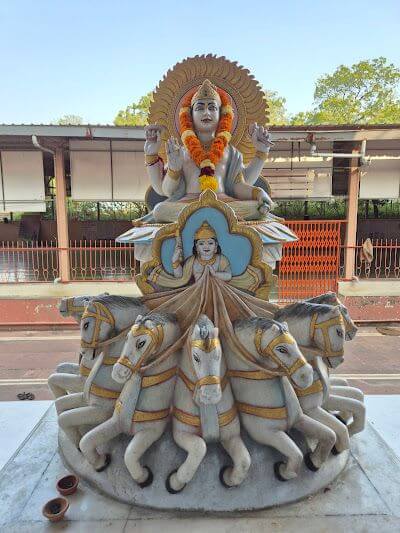 The Radha-Damodar Temple in Surat is one of the many grand and beautiful temples built by the ‘International Society for Krishna Consciousness’ (ISKCON), a global religious organisation founded in the United States. ISKCON follows the Gaudiya Vaishnava tradition, which centres on devotion to Lord Krishna. The chanting of the Hare Krishna Hare Rama mahamantra is the principal spiritual practice of ISKCON. The organisation has played a significant role in spreading the teachings of the Srimad Bhagavad Gita and the principles of Vedic religion worldwide. ISKCON temples are integral to this mission, serving as hubs for spiritual education and devotion. Among the many ISKCON temples across the globe, the Radha-Damodar Temple in Jahangirpura, Surat, holds a special place.
The Radha-Damodar Temple in Surat is one of the many grand and beautiful temples built by the ‘International Society for Krishna Consciousness’ (ISKCON), a global religious organisation founded in the United States. ISKCON follows the Gaudiya Vaishnava tradition, which centres on devotion to Lord Krishna. The chanting of the Hare Krishna Hare Rama mahamantra is the principal spiritual practice of ISKCON. The organisation has played a significant role in spreading the teachings of the Srimad Bhagavad Gita and the principles of Vedic religion worldwide. ISKCON temples are integral to this mission, serving as hubs for spiritual education and devotion. Among the many ISKCON temples across the globe, the Radha-Damodar Temple in Jahangirpura, Surat, holds a special place.
A.C. Bhaktivedanta Swami Prabhupada, also known as Srila Prabhupada, was the founder of ISKCON (International Society for Krishna Consciousness). Born on 1st September, 1896 in Kolkata, his original name was Abhay Charan De. His parents, Gour Mohan De and Rajani, were devout and instilled a love for Krishna devotion in him from a young age. He pursued his education at Scottish Church College in Kolkata, excelling in English, Sanskritand other subjects. In 1922, Prabhupada met Bhaktisiddhanta Saraswati Thakur, a prominent saint of the Gaudiya Vaishnava tradition. In 1933, he formally took initiation from Bhaktisiddhanta Saraswati and became a preacher of the Vaishnava tradition. 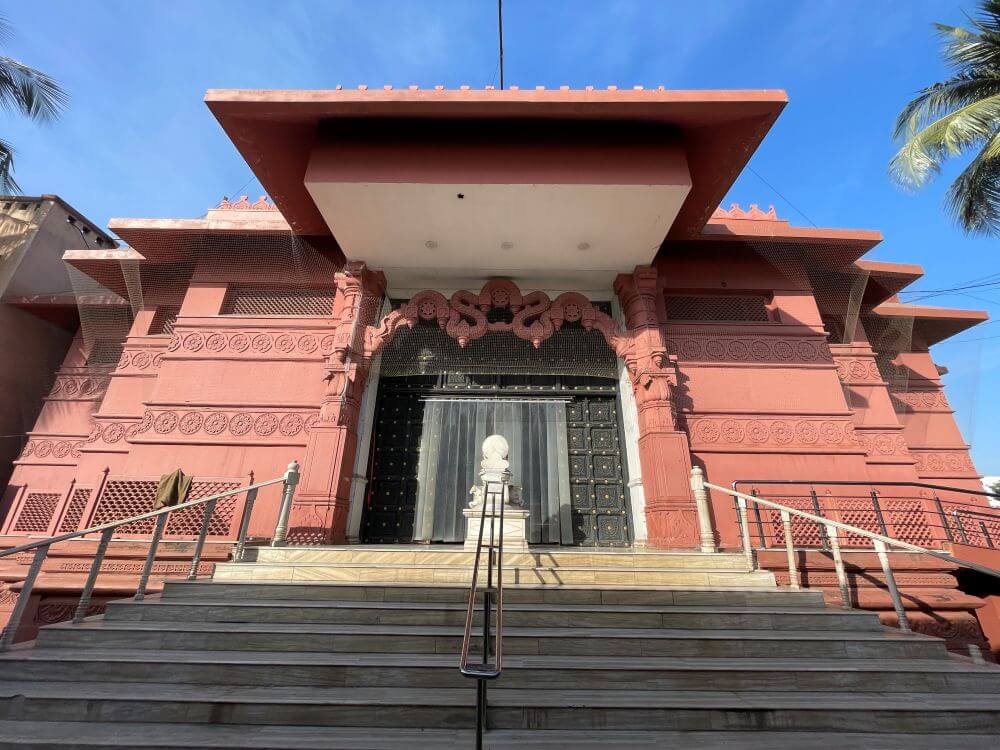 To support his family, he worked in the pharmaceutical business for some time. However, after 1950, he renounced worldly life to fully dedicate himself to Krishna devotion and spiritual outreach. In 1959, he took sannyasa (the renounced order of life) and adopted the name A.C. Bhaktivedanta Swami. Prabhupada’s guru, Bhaktisiddhanta Saraswati, expressed a desire for him to spread Krishna’s teachings and the Vaishnava philosophy in the Western world. Following this, Swami Prabhupada authored Bhagavad Gita As It Is, a commentary on the Bhagavad Gita. He also translated the Srimad Bhagavatam and other Vaishnava texts into English.
To support his family, he worked in the pharmaceutical business for some time. However, after 1950, he renounced worldly life to fully dedicate himself to Krishna devotion and spiritual outreach. In 1959, he took sannyasa (the renounced order of life) and adopted the name A.C. Bhaktivedanta Swami. Prabhupada’s guru, Bhaktisiddhanta Saraswati, expressed a desire for him to spread Krishna’s teachings and the Vaishnava philosophy in the Western world. Following this, Swami Prabhupada authored Bhagavad Gita As It Is, a commentary on the Bhagavad Gita. He also translated the Srimad Bhagavatam and other Vaishnava texts into English.
In 1965, at the age of 69, Swami Prabhupada travelled to the United States despite numerous challenges, including financial hardships and surviving two heart attacks during the journey. 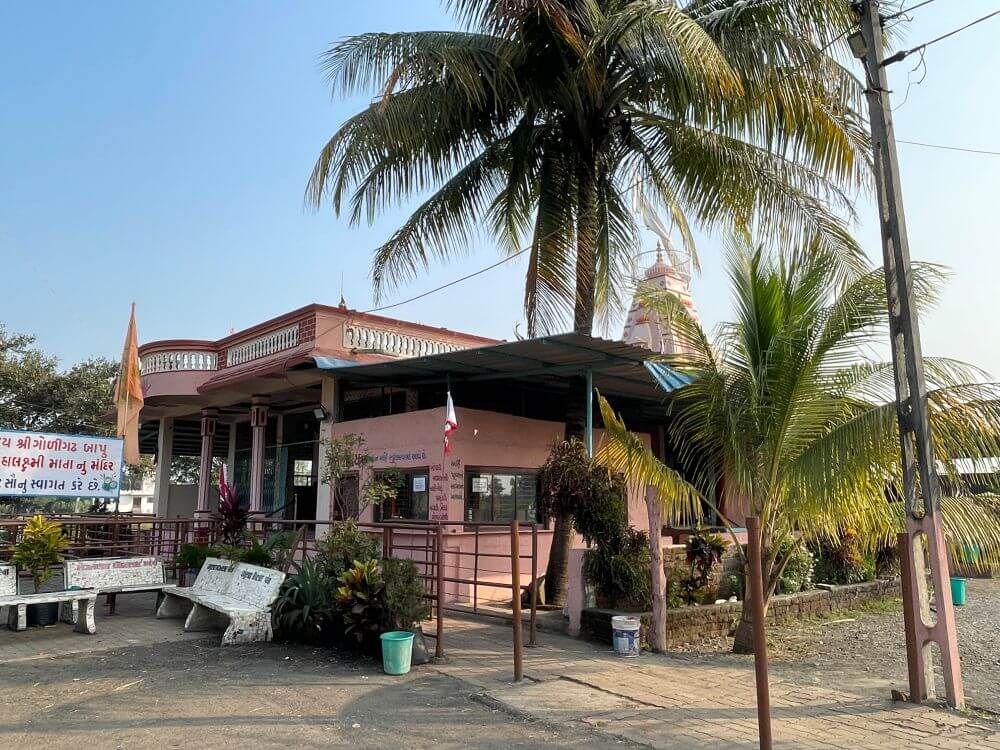 In 1966, he established ISKCON in New York City with the mission of spreading the teachings of the Bhagavad Gita and Vaishnava philosophy globally. He taught the chanting of the Hare Krishna Mahamantra and initiated a worldwide devotional movement.
In 1966, he established ISKCON in New York City with the mission of spreading the teachings of the Bhagavad Gita and Vaishnava philosophy globally. He taught the chanting of the Hare Krishna Mahamantra and initiated a worldwide devotional movement.
Swami Prabhupada authored over 70 books, including commentaries on the Bhagavad Gita, Srimad Bhagavatamand the Chaitanya Charitamrita. Through ISKCON, he also established schools, collegesand universities to promote Vedic education. Initiatives like Food for Life provided meals to the underprivileged. Under his leadership, ISKCON established over 850 temples in more than 100 countries worldwide. Swami Prabhupada left his mortal body on 14 November 1977 at the Krishna-Balaram Temple in Vrindavan. 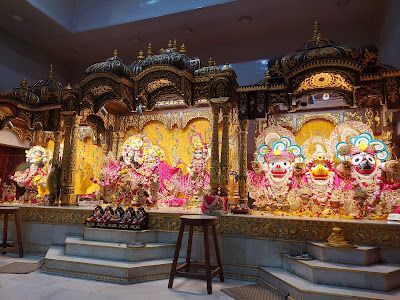 However, his legacy continues through ISKCON, which remains a global spiritual movement. The Radha-Damodar Temple in Surat is a testament to his vision and devotion.
However, his legacy continues through ISKCON, which remains a global spiritual movement. The Radha-Damodar Temple in Surat is a testament to his vision and devotion.
The Radha-Damodar Temple was established in 1978, just a few months after Swami Prabhupada’s passing. Initially built on an area of approximately 900 square feet, the temple has since expanded to cover a sprawling 13,600 square feet. Constructed with pink sandstone imported from Rajasthan, the temple is enclosed by a large boundary wall.
The temple features a grand entrance arch with a large iron gate. At the base of the two sturdy columns supporting the arch, intricately carved relief sculptures of Vaishnava  gatekeepers (dwarapal) can be seen. Upon entering, visitors are greeted by a magnificent circular fountain with a large statue of Lord Krishna subduing the serpent Kaliya (Kaliyamardana). Surrounding the fountain is a beautifully landscaped garden adorned with statues of Radha and Krishna depicted in various graceful dance poses.
gatekeepers (dwarapal) can be seen. Upon entering, visitors are greeted by a magnificent circular fountain with a large statue of Lord Krishna subduing the serpent Kaliya (Kaliyamardana). Surrounding the fountain is a beautifully landscaped garden adorned with statues of Radha and Krishna depicted in various graceful dance poses.
Moving further into the courtyard, on the right-hand side, stands the magnificent Radha-Damodar Temple, entirely constructed from pink sandstone. The temple’s structure comprises a grand assembly hall (sabhamandap) and a sanctum (garbhagriha). The assembly hall is topped with two small spires built in the Fansana style, while the sanctum features a Nagara-style spire in the Urushringa 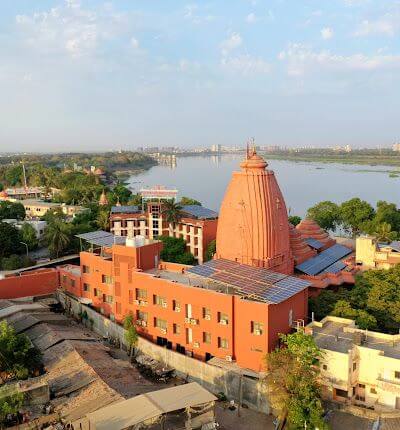 design, where smaller replicas of the main spire are carved onto it. The temple is built on a slightly elevated platform (jagati), with wide marble steps leading to the assembly hall.
design, where smaller replicas of the main spire are carved onto it. The temple is built on a slightly elevated platform (jagati), with wide marble steps leading to the assembly hall.
The assembly hall has large, intricately carved entrances, with decorative makar-toranas (arches with crocodile motifs) on the exquisitely detailed columns. The floor is paved with gleaming marble tilesand the walls are adorned with vivid, large paintings depicting various avatars of Vishnu, significant moments from the lives of Srila Prabhupada and Chaitanya Prabhuand scenes from Krishna’s divine Krishnalila. The ceiling features a mural of Vrindavan’s Raas Leela (Krishna’s dance with the gopis). At the centre of the assembly hall, on an elevated platform, stands a shrine housing an idol of Srila Prabhupada.
In the sanctum (garbhagriha), beautifully decorated golden makhars (ornate canopies) house multiple idols of Lord Krishna and Radha in various forms. The central makhar features the idols of Radha-Damodar, alongside an idol of Savaalya Krishna (Krishna in a darker shade). The makhar on the left displays Radha and Krishna in a dancing pose, symbolising their divine union. The makhar on the right contains idols of Subhadra, Balaramand Lord Krishna, which are replicas of the idols from the Jagannath Temple in Puri. These ornate canopies, adorned with flowers, golden columnsand carved arches, also house small idols of Srila Prabhupada, Gomata (sacred cow)and Krishna in various poses.
Within the temple complex, there is a three-storeyed building housing ISKCON’s office, where large halls are dedicated to the sale of puja materials, religious booksand prasadam (sanctified food). On one side of the complex is the Prabhupada Ashramand near its entrance, a large pavilion displays a chariot of Krishna.
The Rath Yatra (chariot festival) is one of the most significant celebrations at ISKCON temples. It is said that Srila Prabhupada, even as a child, was fascinated by the Rath Yatra festival. At the age of just six, he organised a replica Rath Yatra in Kolkata, inspired by the Jagannath festival in Puri. For this, he convinced his father to buy him a small chariot. Decades later, after moving to the United States, Srila Prabhupada initiated the Rath Yatra tradition there as well. The first Rath Yatra in the US was held on 9th July 1967 in San Francisco. Similarly, in London, the Rath Yatra was first celebrated on 13th July 1972. During a lecture delivered on this occasion, Srila Prabhupada elaborated on the significance of Rath Yatra, quoting the ancient text: ‘Rathe ca vamanam drishtva punarjanma na vidyate.’ Meaning: ‘By beholding the Lord on the chariot, one progresses towards liberation from the cycle of birth and death.’ The Rath Yatra at the Jagannath Temple in Puri, held annually on the second day of the waxing moon in the month of Ashadha (June–July).
The ISKCON Temple in Surat organises a grand Rath Yatra (chariot procession). During the event, the chariot is beautifully decorated with flowersand accompanied by the rhythm of conch shells, mridangams, drumsand cymbals, thousands of devotees chant the Hare Krishna Hare Rama mantra. This Rath Yatra is considered the largest in South Gujarat. The procession begins near the Surat Railway Station and follows a route through Delhi Gate, Sahara Darwaja, Man Darwaja, Udhna Darwaja, Majura Gate, Athwa Gateand Palanpur Patia, finally reaching Jahangirpura, where it concludes at the ISKCON Temple.
The temple hosts daily aarti, kirtan (devotional singing), discoursesand prasadam distribution. Festivals like Janmashtami (Lord Krishna’s birth) and Radhashtami (Radha’s birth) are celebrated with immense enthusiasm, accompanied by the chanting of Hare Krishna Hare Rama. During these celebrations, the temple is filled with devotees, including a significant number of youth. Enthralled by the rhythm of Krishna bhajans (devotional songs), devotees immerse themselves in devotion through singing and dancing.
